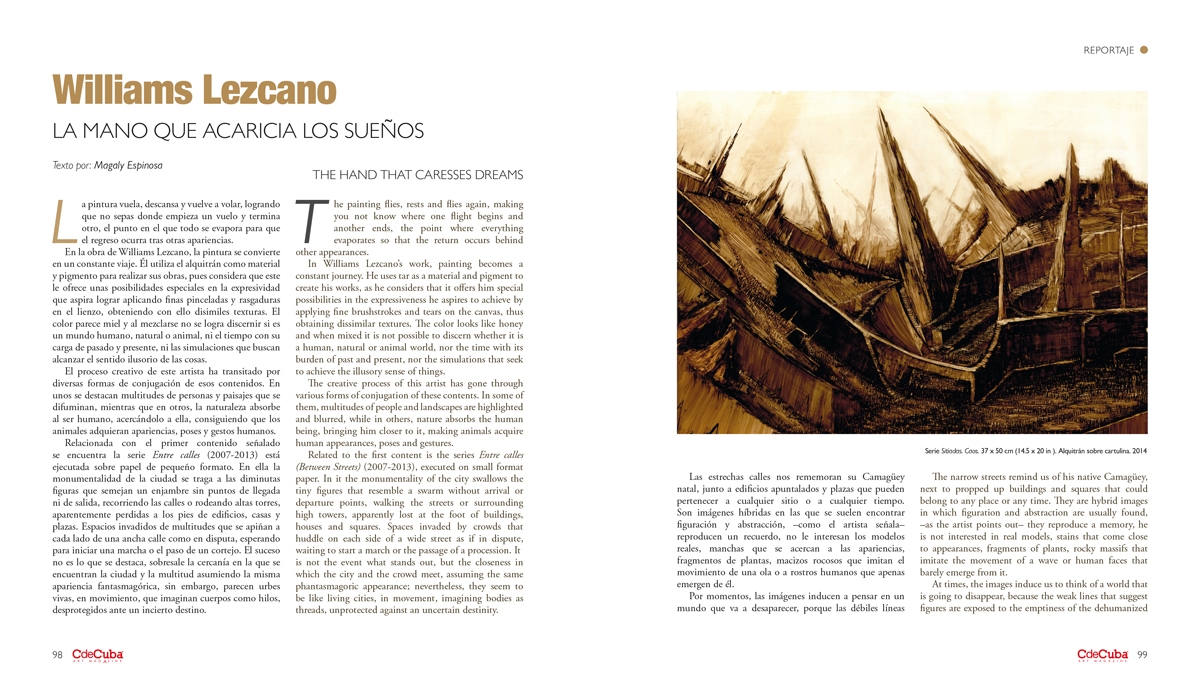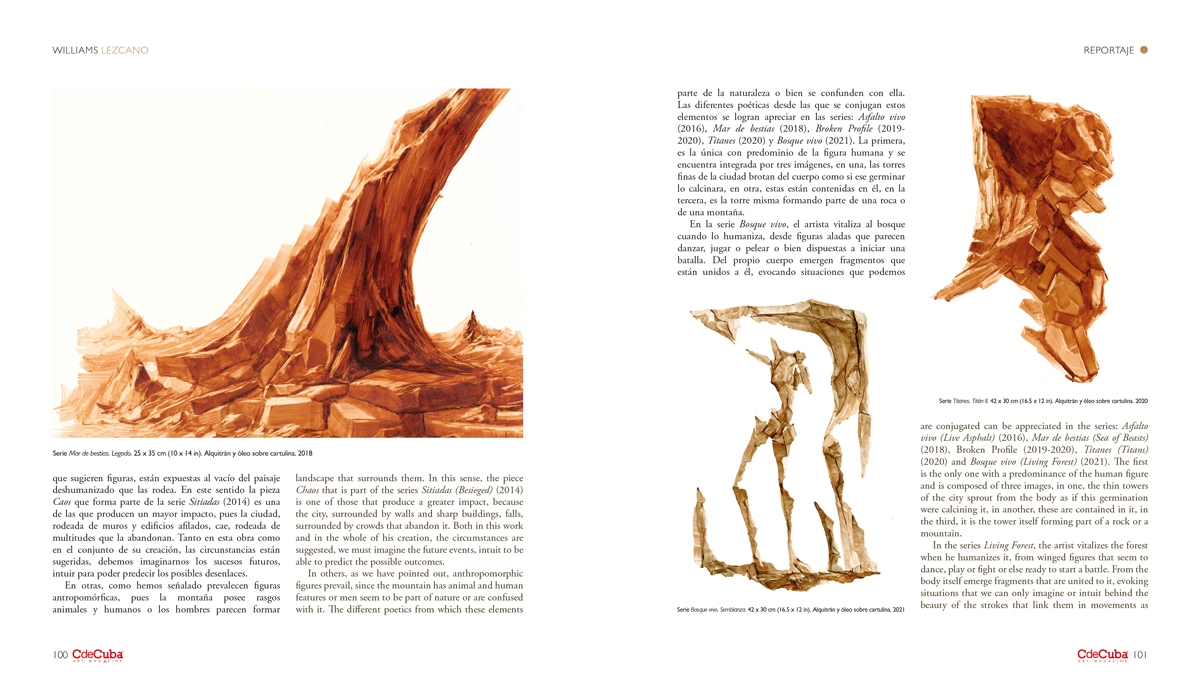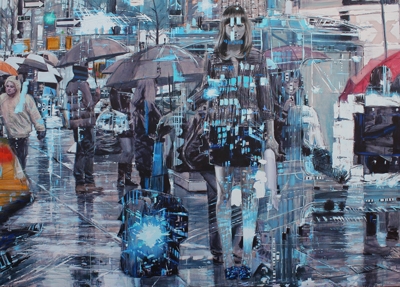The Hand That Caresses Dreams
By Magaly Espinosa
The painting flies, rests and flies again, making you not know where one flight begins and another ends, the point where everything evaporates so that the return occurs after other appearances.
In Williams Lezcano’s work, painting becomes a constant journey. He uses tar as a material and pigment to create his works, as he considers that it offers him special possibilities in the expressiveness he aspires to achieve by applying fine brushstrokes and tears on the canvas, thus obtaining dissimilar textures. The color looks like honey and when mixed it is not possible to discern whether it is a human, natural or animal world, nor the time with its burden of past and present, nor the simulations that seek to achieve the illusory sense of things.
The creative process of this artist has gone through various forms of conjugation of these contents. In some of them, multitudes of people and landscapes are highlighted and blurred, while in others, nature absorbs the human being, bringing him closer to it, making animals acquire human appearances, poses and gestures.
Related to the first content is the series Entre calles (Between Streets) (2007-2013), executed on small format paper. In it the monumentality of the city swallows the tiny figures that resemble a swarm without arrival or departure points, walking the streets or surrounding high towers, apparently lost at the foot of buildings, houses and squares. Spaces invaded by crowds that huddle on each side of a wide street as if in dispute, waiting to start a march or the passage of a procession. The event is not what stands out; what stands out is the closeness in which the city and the crowd meet, assuming the same phantasmagoric appearance; nevertheless, they seem like living cities, in movement, imagining bodies like threads, unprotected before an uncertain destiny.
The narrow streets remind us of his native Camagüey, next to propped up buildings and squares that could belong to any place or any time. They are hybrid images in which figuration and abstraction are usually found, because as he points out, they reproduce a memory, he is not interested in real models, stains that come close to appearances, fragments of plants, rocky massifs that imitate the movement of a wave or human faces that barely emerge from it.
At times, the images induce us to think of a world that is going to disappear, because the weak lines that suggest figures are exposed to the emptiness of the dehumanized landscape that surrounds them. In this sense, the piece Chaos that is part of the series Sitiadas (Besieged) (2014) is one of those that produce a greater impact, because the city, surrounded by walls and sharp buildings, falls, surrounded by crowds that abandon it. Both in this work and in the whole of his creation, the circumstances are suggested, we must imagine the future events, intuit to be able to predict the possible outcomes.
In others, as we have pointed out, anthropomorphic figures prevail, since the mountain has animal and human features or men seem to be part of nature or are confused with it. The different poetics from which these elements are conjugated can be appreciated in the series: Asfalto vivo ( Live Asphalt) (2016), Mar de bestias (Sea of Beasts) (2018), Broken Profile (2019-2020), Titanes (Titans) (2020) and Bosque vivo (Living Forest) (2021). The first is the only one with a predominance of the human figure and is composed of three images, in one, the thin towers of the city sprout from the body as if this germination were calcining it, in another, these are contained in it, in the third, it is the tower itself forming part of a rock or a mountain.
In the series Living Forest, the artist vitalizes the forest when he humanizes it, from winged figures that seem to dance, play or fight or else ready to start a battle. From the body itself emerge fragments that are united to it, evoking situations that we can only imagine or intuit behind the beauty of the strokes that link them in movements as delicate as the figures themselves. Among his latest series, very close to the aesthetic dispositions of those mentioned above, are: Fábulas (Fables) (2020-2022) and Insomnio (Sleeplessness) (2021). In the first, which takes its name from a literary genre, in which the characters that inhabit it are usually animals that personify human actions and postures, following this principle, Williams places various animals, powerful, weak and small, on a boat piled together as if they sprouted from the same body, like an octopus that expands its tentacles. Following this aesthetic and forming part of this series, the piece La nave de los locos (The Ship of Fools) will occupy a particular space: five versions place the animals in different circumstances, always facing in the opposite direction, some to the right and others to the left, protecting each other while waiting for their arrival at their destination. In one of the S/T versions, the ship breaks down and the animals it transports shoot off in all directions; in another, also S/T, there are two groups of animals, those on the left jump into the water to reach the ship in front of them, also full of animals.
It is a Noah’s Ark, composed only of animals, which do not go in pairs, nor do they try to save themselves from a universal cataclysm, they only sail, but the poses of rest and alertness, announce a wait for what may happen on the voyage.
In the second series, a group of skeletal animals pose sideways and we only see their torso and face, some awake, others halfway between life and death, looking in only one direction. In two of the pieces that integrate it, the animals are sunk in the white background of the paper, all of them look serious, immutable, and the calmness they show suggests that they have reached an agreement.
As a whole, the series becomes a story that narrates the vicissitudes of its protagonists, some of them go from apparent rest to jumping, to the attempt of salvation, others evaporate hiding in nature, those who slip into their city, thus containing, from such dissimilar events, the unknowns that all narration bears on the destinies of its protagonists, for them time passes in such a way that makes possible the coexistence of the past with the present. The twists of the imagination distort the real, embellishing it or giving entry to dreams, because in them it does not matter what is credible, it is enough what is invented by memory, the subconscious or the remains of the days lived.






